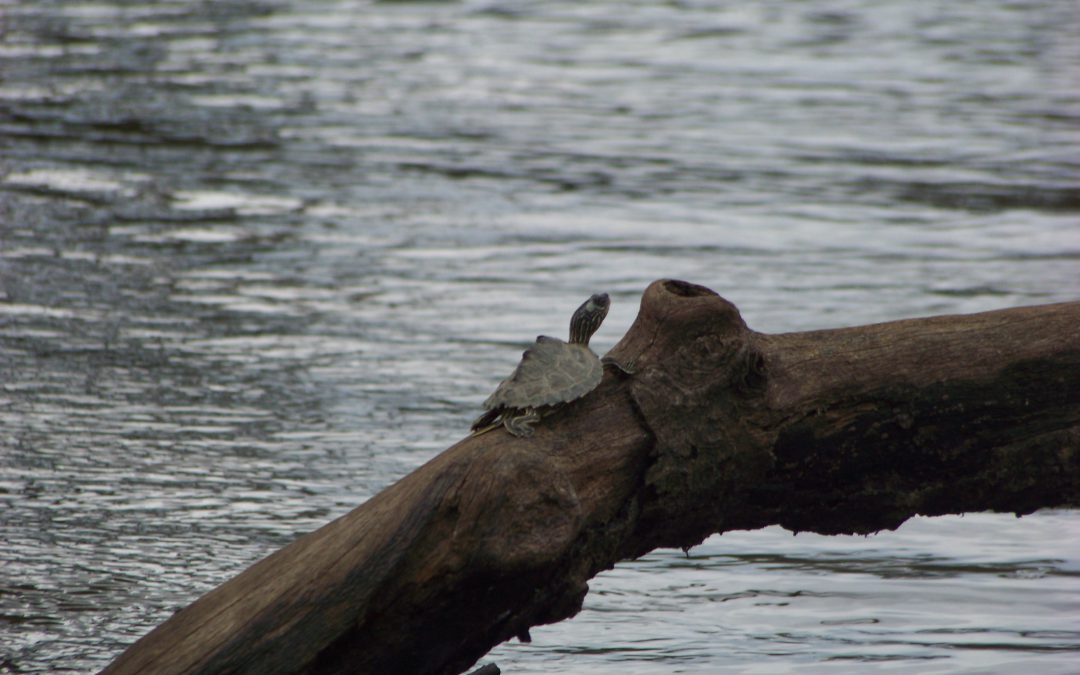
by Rick O'Connor | May 3, 2020
Map turtles (Graptemys) are pretty common across much of the eastern and midwest areas of the United States. Not so much in Florida. There are only two species, and they are only found in the panhandle. However, the range for those two species is mostly in Florida making them a unique Florida turtle, and ones that both the state and federal agencies monitor for occurrence.
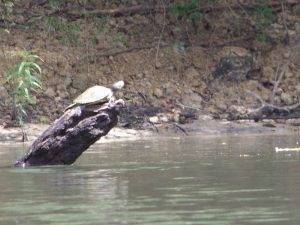
The Barbour’s Map Turtle sitting on a tree stump in the Chiploa River.
Photo: Molly O’Connor
In the 1940s and 50s it was believed that the Barbour’s Map Turtle (Graptemys barbouri) was only found in the Apalachicola River and the Escambia Map Turtle (Graptemys ernsti) was only found in the Escambia. As a matter of fact, with much of the Escambia River actually in Alabama, they were not sure whether the Escambia Map Turtle was different from the Alabama Map Turtle ( Graptemys pulchra) that inhabits the upper reaches of the Escambia River in Alabama, where they call it the Conecuh River.
Today they do now consider it a separate species and they also know these turtles are found in other rivers in the panhandle. As a matter of fact, there may be more Barbour’s Map Turtles in the Chipola River than in the Apalachicola.
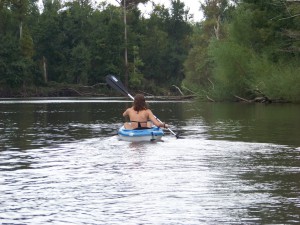
Paddling the Escambia River.
Photo: Molly O’Connor
This is definitely a river turtle – preferring stronger currents with plenty of fallen trees (snags) to bask on – something they like to do a lot of. The females are twice as large as the males, with very wide heads and powerful jaws for crushing mollusk shells – their favorite food. Males are much smaller and feed primarily on insects and other aquatic invertebrates. Because of their preference for mollusk, they are usually not found in tannic rivers, like Blackwater or Perdido Rivers, where the pH is to low for successful shell development. And even on the more alluvial rivers, they are not common in the quiet backwater areas of the floodplain swamps – they really like the currents where the mollusk are.
The Barbour’s Map Turtle differs from the Escambia Map in that (a) they have circular yellow patterns on each scute (scale) of the olive green to brown carapace (top shell), (b) lack the two large yellow spots on the top of the head, behind the eye that you find in the Escambia Map, (c) lack the dark black stripe running down the middle keel of the carapace you find in the Escambia Map, (d) the rivers they inhabit.
Barbour’s Map Turtles are found in the rivers between (and including) the Choctawhatchee River and the Apalachicola River. There have been records of Barbour’s Map Turtle in the Ochlockoknee River, but it is believed they may have been moved there by humans.
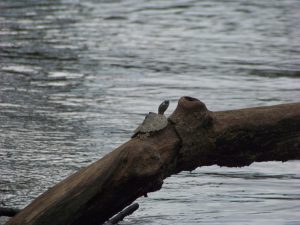
The Escambia Map Turtle is only found in the Escambia, Yellow, and Shoal Rivers.
Photo: Molly O’Connor
The Escambia Map Turtle is found in rivers that feed into Pensacola Bay. These would include the Escambia, Yellow, and Shoal Rivers – again, Blackwater is too tannic. There is discussion whether the Escambia Map has been found in the Choctawhatchee, and there may be some hybridization occurring here.
On rivers where they are found, map turtles can be some of the most common turtles seen. They have high domes shells, that look more “inflated” towards the head end, and scales that form jagged points sticking up along the mid-line of the shell. This gives them a “dinosaur” appearance and another common name “sawbacks”. They are not big turtles, when compared to others like softshell, cooters, snappers – reaching a maximum shell length of 12 inches – are often seen basking on fallen trees (snags) in the water. They are skittish and hard to get close to. Many will jump into the water when you are still over 300 feet away. But for those patient enough to drift, you should get a closer look, and maybe even a picture. On one paddle I did on the Escambia River they made up over 75% of the turtles we saw in a one-mile stretch.
The Barbour’s Map prefers sections of the river where the current is strong and limestone outcrops are frequent. These limestone sections are home to a variety of snail species – the female’s favorite food. Like so many other turtles, they do have to have sandy beaches for nesting. They will venture downstream to find these where the river makes sharp turns and may venture as far as 350 feet inland looking for a suitable nesting spot. Here raccoons do their damage. They not only consume the eggs but will prey on the adults as well. It is also known that occasionally bald eagles will target map turtles as food.
Times are harder for the Barbour’s Map Turtle. In the 1950s there were reports of as many as 136 map turtles / mile. Today the numbers are more like 5-10. The decline can be attributed to several issues.
1) Human harvest. Though not as frequent today, there are records of human harvesting within their range, particularly in the Chipola River area.
2) Dams. Altering the river flow and available “snags” has impacted their numbers.
3) Removing “snags”. This is done for both navigation issues with boaters and because there are unsightly to some. However, map turtles need them – as do other riverine wildlife.
4) “Plinking”. This is a “sport” that is not as common as it once was, but still happens. This is when humans use basking turtles as target practice.
All of these, and probably others, have contributed to this decline and forced the state to protect them. They are now listed on Florida’s Imperiled Species List and you are not allowed to possess them.
The Escambia Map Turtle is still very common on the Escambia River. However, all the members of this species only live on three short rivers, and Florida is concerned that they numbers could be wiped out with a catastrophic event.
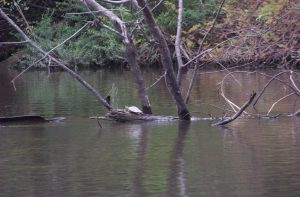
An Escambia Map Turtle in a more quiet portion of the river.
Photo: Molly O’Connor
This portion of Florida lacks the limestone substrate you find further east. The Escambia River was home to one of the greatest variety of mussels in the Florida rivers. This is their choice of food over snails. However, pollution from agriculture and a paper mill in the Alabama portion of the river, as well as altered flow and sediments due to dams in the Alabama portion, have caused a decline in the mussels. Interestingly, the non-native Asian Clam was accidentally introduced to all the river systems in the panhandle, and the map turtles love them. Some believe the introduction of the Asian Clam may have “saved” the Escambia Map.
In addition to the stressors mentioned with the Barbour’s Map, the Escambia Map has had problems with local ATVs riding all over their nesting beaches destroying nests. Because of their small geographic range, and the increase in potential threats, Florida prohibits the possession of this map turtle as well.
The cool thing about these map turtles is that they are only found in a small area of the planet – in our north Florida rivers. I hope we can protect them, and that you get to see some one day.
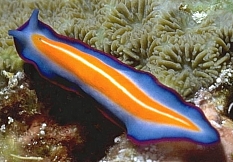
by Rick O'Connor | Apr 30, 2020
Okay, this is a gamble.
I began this series to celebrate the year of the Gulf of Mexico – “Embracing the Gulf 2020”. The idea was to write about the habitats, creatures, economic impacts, and issues surrounding the “pond” that we live on. I did a few introductory articles and then jumped right into the animals. We began with the fun ones – fish, sea turtles, whales – and now we are in the more unfamiliar – invertebrates like sponges and jellyfish.
But worms? Really? Who wants to read about worms?
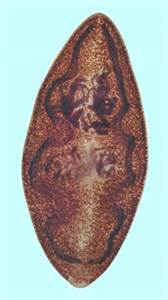
A classic flatworm is this lung fluke.
Photo: Kansas State University.
Well, there are a lot of them, and they are everywhere. You will find in many sediment samples that worms dominate. They also play an important role in the marine community. They are great scavengers, cleaning the environment, and an important source of food in the food chains of the more familiar animals. But they are gross and creepy. When we find worms, we think the environment is gross and creepy – and sometimes it is, remember they CLEAN THE ENVIRONMENT. But worse is that many are parasites. Yes… many of them are, and that is certainly gross and creepy. Flukes, tapeworms, hookworms, leeches, who wants to learn amore about those? Well, honestly, parasitism is an interesting way to find food and the story on how they do this is pretty interesting… and gross… and creepy. Let’s get started.
According to Robert Barnes’ 1980 book Invertebrate Zoology, there are at least 11 phyla of worms – it is a big group. We are not going to go over all of them, rather I will focus on what I call the “big three”: flatworms, roundworms, and segmented worms. We will begin with the most primitive, the flatworms.
As the name implies, these worms are flat. They are so because they are the last of what we call the “acoelomate” animals. Acoelomates are animals that lack an internal body cavity and, thus, have no true body organs – there is no where for them to go. So, they absorb what they need, and excrete, through special cells in their skin. To be efficient at this, they are flat – this increases the surface area in contact with the environment. There are three classes of flatworms – one free swimming, and two that are parasitic.

This colorful worm is a marine turbellarian.
Photo: University of Alberta
The free-swimming ones are called turbellarians. Most are very small, look like leaves, very colorful, and undulate as they swim near the bottom. They have “eye-like” cells called photophores that allow them to see light – they can then choose whether to move towards the dark or not. They have nerve cells but no true brain, and one only one opening to the digestive tract – that being the mouth, so they must eat and go to the bathroom through the same opening. Weirder yet, the mouth is usually in the middle of the body, not at the head end. Some are carnivorous feeding on small invertebrates, others prefer algae, others are scavengers (CLEANING THE OCEAN). They can reproduce by regenerating their bodies but most use sexually reproduction. They are hermaphrodites – being both male and female. They can fertilize themselves but more often seek out another worm. Fertilization is internal and they lay very few eggs.
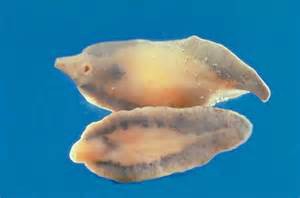
The human liver fluke. One of the trematode flatworms that are parasitic.
Photo: University of Pennsylvania
The second group are called trematodes and they are the parasites we know as “flukes”. We have heard of liver flukes in livestock and humans, but there are marine versions as well. They have adhesive organs located at the near the mouth that help hold on, and a type of skin that protects them from their hosts’ defensive enzymes. They feed on cells, mucous, and sometimes blood – yep… gross and creepy. Some are attached outside of their hosts body (ectoparasites) others are attached to internal organs (endoparasites). The ectoparasites breath using oxygen (aerobic), endoparasites are anaerobic. Like their turbellarian cousins, they are hermaphroditic and use internal fertilization to produce eggs. They differ though in that they produce 10,000 – 100,000 eggs! Their primary host (the one they spend their adult life feeding on) is always a vertebrate, fish being the most common. However, their life cycle requires the hatching larva find an intermediate host where they go through their developmental growth before returning to a primary host. These intermediate host are usually invertebrates, like snails. The eggs are released with the fish feces – a swimming larva is released – enters a snail – begins part of the developmental growth – consumed by an arthropod (like a crab) – completes development – and the crab is consumed by the fish – wah-la. The adults are usually found in the gills/lungs, liver, or blood of the vertebrate hosts. Gross and creepy.
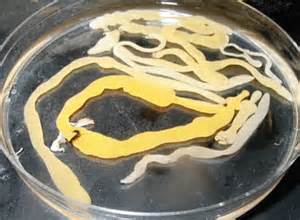
The famous tapeworm.
Photo: University of Omaha.
Better yet are the tapeworms. We have all heard of these. They are also all parasites, but all are endoparasites. Weirder, they do not have a digestive tract. Gross and creepy. Their heads are very tiny compared to their bodies and have either four sets of suckers, or hooks, to hold onto the digestive tract of their hosts (usually vertebrates). The head is actually round but the body is very flat and divided into squares called proglottids. Each proglottid gets larger as you move towards the tail and each possesses all of the reproductive material needed to produce new worms – they too are hermaphrodites. They also have a type of skin that protects them from the enzymes of their hosts. They also require an intermediate host to complete their life cycle so the proglottids will exit the hosts body via feces and complete the cycle similar to the trematodes.

I began this with a comment on how worms benefit the overall marine environment of the Gulf. It is hard to see that in these flatworms. They are either just another consumer out there, or nasty parasites others in the community must deal with. Well… we look at the roundworms next time and see what they have to offer.
Reference
Barnes, R. 1980. Invertebrate Zoology. Saunders College Press. Philadelphia, PA. pp. 1089.
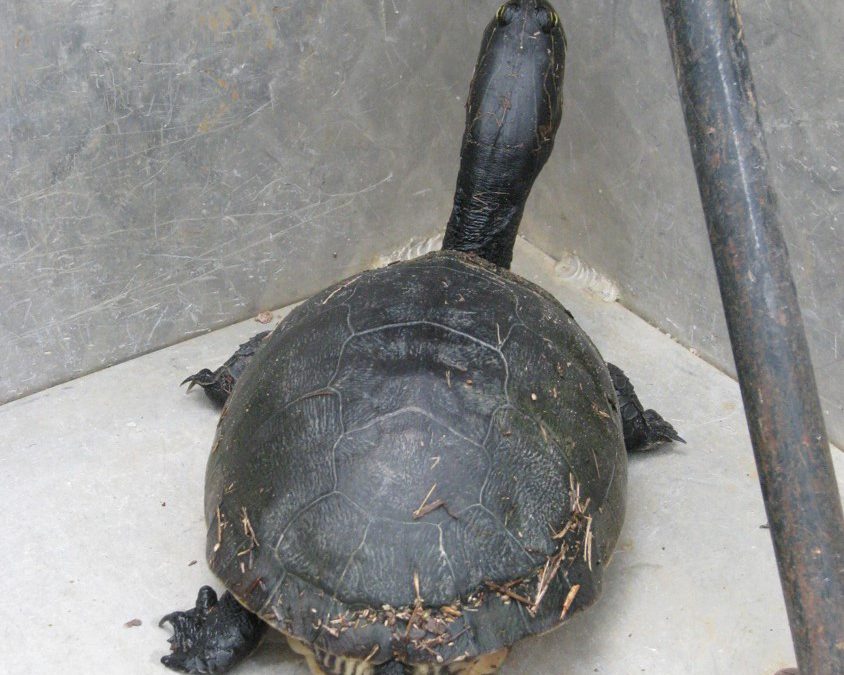
by Rick O'Connor | Apr 19, 2020
Bet you have never heard of these?
Chicken Turtles?
But they exist!
And the reason you probably have not heard of them is because, unlike so many other turtles, they do not spend a lot of time in the water.
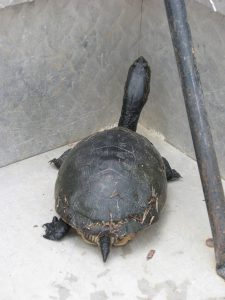
The long neck and oval shell of the Florida Chicken Turtle.
This one is missing a rear leg, probably attacked by a raccoon.
Photo: Molly O’Connor
Chicken turtles are fans of the ephemeral ponds, these are ponds that have water in them after heavy rain but are dry otherwise. These turtles inhabit such locations and hide in the brush and leaf litter during the dry periods. They are predators within this system, feeding on insects and crayfish mostly.
It is one of the many emydid turtles and their shells are more oval in shape than round. It is a dark black to olive color and has a distinct pattern of yellow stripes looking like a fish net on the shell. Most shells are in the 10-inch range in length and, like many species of turtles, the males are smaller. The plastron (belly shell) is a beautiful solid creamy yellow color with no dark marking at all.
This turtle is found in the Atlantic coastal plains and there are two subspecies found in Florida: Deirochelys reticularia reticularia and D. r. chrysea. The primary difference is that D. r. reticularia has a single dark spot on the underside of the marginal scutes of the bridge connecting the carapace to the plastron; D. r. chrysea does not have these spots. D. r. reticularia are found north and west of the Suwannee River and D. r. chrysea are found in the peninsula south of the Suwannee.
Most of the ponds where these turtles have been found are less than 20 inches deep. It seems to avoid river flood plains, preferring small ponds in savannas, sandhill depressions, and wetlands. They seem to be out more in the early mornings and shortly after sunset.
Unlike most emydid turtles, chicken turtles BEGIN their nesting season in August and continue into the winter. The females wander over open ground seeking good nesting sites. They prefer open grassy areas and dig the nest during daylight hours. The average number of eggs deposited is around 10 and, like other turtles, more than one clutch will be laid each season.
They do not seem to be very abundant in the ponds they inhabit; 3-5 turtles/hectare seems to about the norm. When encountered in the water, they seem to be solitary. As mentioned, their favorite foods are arthropods – primarily insects and crayfish.
It appears one of the largest threats in our state is roadkill. Seasonal changes in rainfall force the turtles to move and, being more active in winter when we have more visitors, road kills are common. Raccoons also take quite of few from their habitat of not living in deep water. And there is ALWAYS the issue of habitat loss – the number one cause of biodiversity declines everywhere. Florida continues to grow, and these turtles will continue to be threatened.
I have only found one of these in the years I have been “turtling”. It was pretty exciting, and it was a day or so before we figured out what kind it was – you don’t see chicken turtles very often, so it was a surprise. It was missing one leg, we are guessing raccoon attack, and we kept it for the afternoon before letting it go. I have not seen one since.
That said, they are around – and I hope you find one someday. It is one of those rare finds.
Hopefully, you will be able to get out and discover many of Florida’s turtles during this YEAR OF THE TURTLE.
References
Meylan P.A. (Ed). 2006. Biology and Conservation of Florida Turtles. Chelonian Research Monographs No.3, 376 pp.
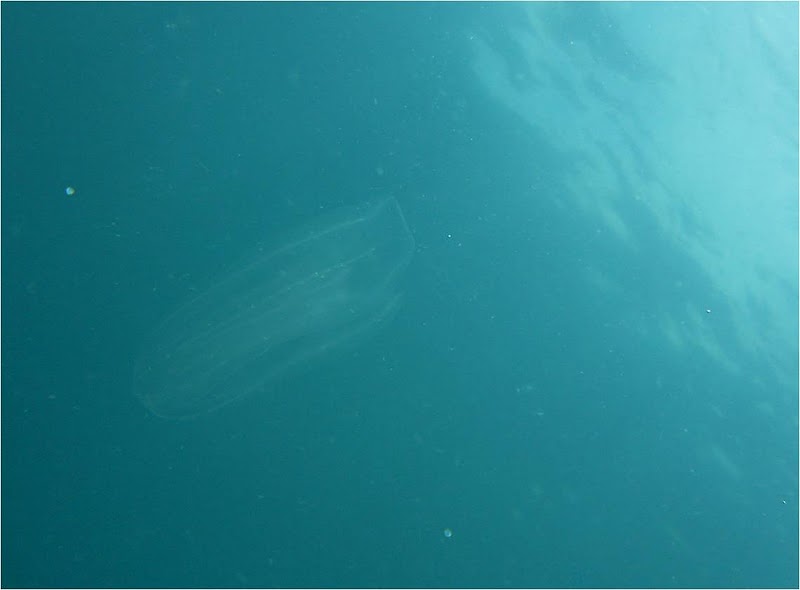
by Rick O'Connor | Apr 17, 2020
I’d like to be a jellyfish… cause jellyfish don’t pay rent…
They don’t walk and they don’t talk with some Euro-trash accent…
Their just simple protoplasm… clear as cellophane
They ride the winds of fortune… life without a brain
These lyrics from Jimmy Buffett’s song Mental Floss sort of sums it up doesn’t it. The easy-going lifestyle of the jellyfish.
Everyone who visits the Gulf coast knows about these guys, but few people… very few… like them. For most, the term jellyfish signals “pain”, “fear”, and “death”. The purple flag is flying, and no one wants to enter the water. Folks from the Midwest call local hotels and condos asking, “when are the jellyfish going to be there?” It’s understandable. Who wants to spend their week vacation on the Gulf inside a hotel because you can’t go swimming?
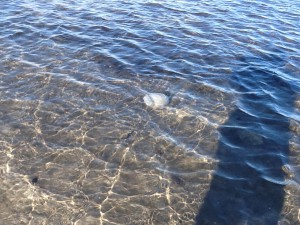
I found this along the shore last winter. These are cannonball jellyfish.
I would almost (…almost) rather be diving with a shark than hundreds of jellyfish. When you spot them, they are everywhere. Quietly swarming like ghosts. You push them off and they appear to move towards you – almost like smoke from a campfire, you can’t get away.
They are creepy things. But amazing too!
As Mr. Buffett’s points out, they are simple “protoplasm”. Their body is primarily a jelly-like substance called mesoglea – and most of that is water. If you place a dead jellyfish on your dock and come back that afternoon, you will probably find just a “stain” of where it was – there is almost nothing to them.
The “bell” of the jellyfish is mostly mesoglea. Some jellyfish have thick layers of this, others much thinner. Some have a small flap of skin along the margins of the bell called the velum which they can undulate and swim – but they are not strong swimmers. If the tide is going out, swim as they may… their heading out also.
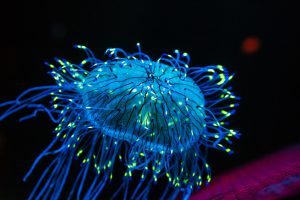
The bell shaped body of a jellyfish with numerous tentacles.
Many species of jellyfish have interesting markings within the bell. One has a white-colored structure that forms a 4-leaf clover. Another has red triangles all connecting at the center of the bell. For many, these structures are the ones that produce the gametes. Jellyfish reproduce sexually but are hermaphroditic – meaning they produce female eggs and male sperm in the same animal. There is no physical contact between animals, they just release the gametes into the ocean when they are in thick swarms and wah-la… new jellyfish – many new jellyfish.
On the bottom of the bell is a single opening that leads to a single pouch. This opening is the mouth, and the pouch is called the gastrovascular cavity. Jellyfish are predators – carnivores. There are no teeth, and most do not seek their prey – their prey finds them. Hanging from their bell are the tools of the killing trade, the part of this animal we do not like… the tentacles. Some tentacles can extend for several feet beyond the bell, others you can hardly notice them – but this is where the killing happens.
Along the tentacles there are small capsules called cnidoblasts which contain small cells called nematocyst. These nematocyst contain a coiled dart which at the end contains a drop of venom. There is a trigger associated with this cell. The jellyfish does not fire it – instead, the prey bumps the trigger and the nematocyst “fires”. The drop of venom is injected, along with the hundreds of other nematocysts along the tentacle the fish just bumped. This venom paralyzes the prey, other tentacles coil around it firing more nematocysts, and the tentacles retract towards the mouth – bingo… lunch.
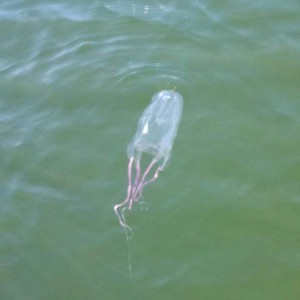
This box jellyfish was found near NAS Pensacola in November of 2015.
Photo: Brad Peterman
Of course, the same happens when people bump into them. For us it is painful and unpleasant – but we are not consumed. That said, some species are quite painful. Some will force people to the hospital, and some have even killed people. The Box Jellyfish is the most notorious of these deadly ones. Known for their habits in Australia, there are at least two species found in the Gulf. The ones found here are not common, and there are no reported deaths, but they do exist. The Four-Handed is the one more widespread here. It actually has eyes, can detect predators and prey and swim towards or away from them, and the male fertilizes the female internally – not your typical jellyfish.
The more familiar painful one is the Portuguese Man-of-War. This creature is more like a sponge in that it is not just one creature but a large “condo” of many. Some cells are specialized in feeding, these are found on their long tentacles. Others specialize in reproduction; these are found near the blue colored air bag. They produce this blueish colored air bag which is exposed above the surface. The wind pushes on the bag like a sail and this moves the creature across the environment in search of food. Hanging from the bag are long tentacles which are made up of individuals whose stomachs are all connected. So, when one group of cells makes contact and kills a prey – they consume it and the tissue is moved through the connecting stomachs to feed the whole colony. To feed a whole colony, you need a big fish – to kill a big fish, you need a strong toxin, and they have it. These are VERY painful and have put people in the hospital, some have died. Some say that the Portuguese man-of-war is not a “true” jellyfish. This is true in the sense that they belong to a different class of jellyfish. There are three classes, the Scyphozoans being what we call the “true” jellyfish – Portuguese man-of-wars are not scyphozoans, but rather hydrozoans.
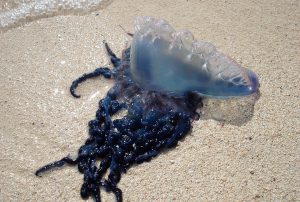
The colonial Portuguese man-of-war.
Photo: NOAA
Another interesting thing about jellyfish, is that they are all not jellyfish-like. As we just mentioned, there are two other classes and one other phylum of jellyfish-like animals. Hydrozoans and anthozoans are not your typical jellyfish. Rather than being bell-shaped and drifting in the ocean looking for food, they are attached to the seafloor and look more like flowers. Their tentacles are usually smaller but do contain nematocysts. Their toxin can be strong, some do eat fish, but most have a weaker toxin and feed on very small creatures – some only eat plankton. These would include the hydra, sea anemones, and the corals. As mentioned above, this also would include the Portuguese man-of-war.
Comb jellies are those jellies that drift in the currents and have no tentacles. We commonly collect them and toss them at each other. When I was growing up, we referred to them as “football jellies” because of this. The reason they do not sting is not because they do not have tentacles (some species do) but rather they do not have nematocyst and cannot. Rather they have special cells called colloblast that produce a drop of sticky glue at the end which they use to capture prey. Not having toxins, they cannot kill large prey but rather feed on smaller creatures like plankton and each other – they are cannibals. For this reason, they are in a whole different phylum.
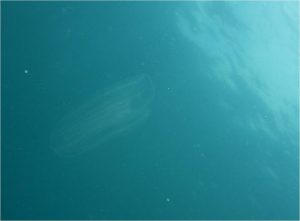
The nonvenmous comb jelly.
Photo: Bryan Fluech
The jellyfish of the Gulf are a nuisance at times but are actually amazing creatures.

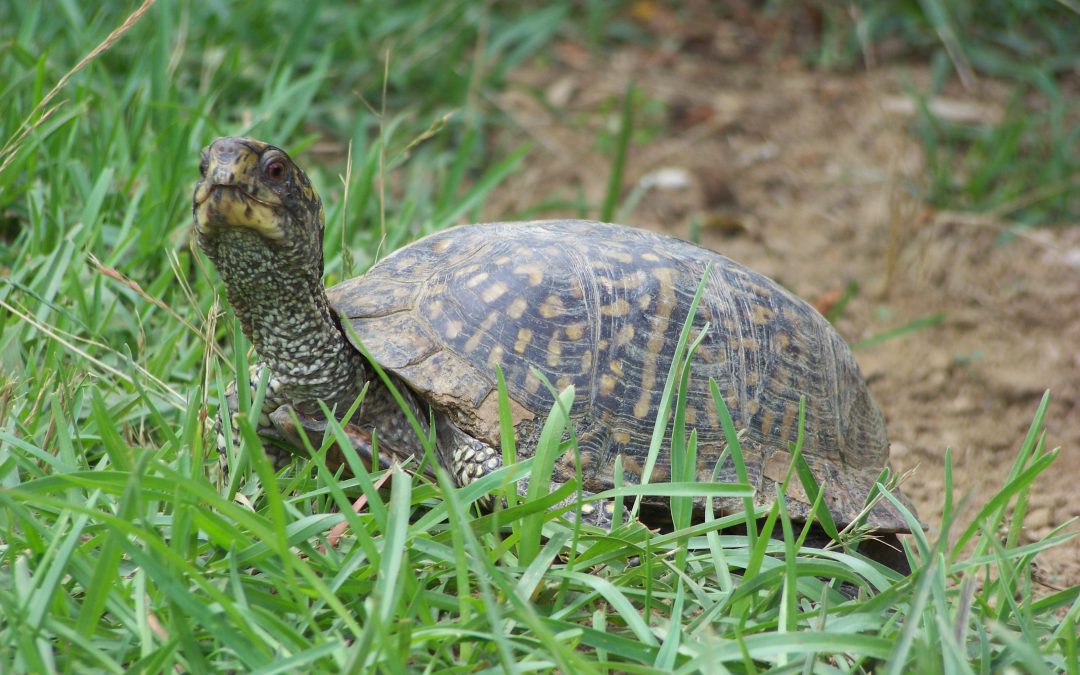
by Rick O'Connor | Apr 7, 2020
These are some of the more familiar Florida turtles we have. Working with youth, I often hear them called “snapping turtles” because (a) these are the most common turtles they encounter, and (b) snapping turtles are the only name they know 😊
I myself had a “pet” box turtle when I was young named… “snappy”. Yep…
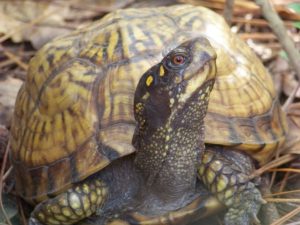
This Gulf Coast box turtle has a lot of yellow on the shell. Their shell coloration varies.
Photo: Molly O’Connor
That said, they do seem to be very common everywhere. Neighborhoods, parks, gardens, farms, you name it, people find these things. However, research suggests that the “commonness” of these guys maybe just in encounters with the same individuals, we really do not know how common they are.
They are a great way to introduce youth to the world of turtles. When picked up they quickly withdraw and close their shells – the only turtles we have that can completely do this (watch out though, they do have a habit of urinating when held).
There is debate as to how many kinds of box turtles we have. Most agree that the four that have been listed are all subspecies of Terrapene carolina. This turtle is typically called the “Eastern” box turtle. This species does exist and is quite common along the Atlantic seaboard. If differs from other subspecies in that the back end of the carapace ends abruptly – there is no “flare” to the margins of the carapace.

The lined pattern of this carapace identifies it as the Florida box turtle.
Photo: Florida Museum of Natural History
What they do agree on is that two subspecies – the Florida box turtle (T. carolina bauri) does live in Florida – in the peninsular part of the state; and the Gulf Coast box turtle (T. c. major) does as well – in the panhandle. The two that are questionable are the Eastern box turtle (T. c. carolina) and the Three-toed box turtle (T. c. triunguis). As said before the Eastern definitely exists north of us but not sure whether it is in Florida. The Three-toed lives west of us but, again, not sure in Florida.
The Florida box turtle has a dark carapace with straight lined yellow streaks (like a sunbeam burst) pattern across its shell. The back end of the shell ends abruptly as it does in the Eastern. The Gulf Coast box turtle is the big boy of the group. Most of these box turtles have carapace lengths no more than 7 inches long. The Gulf Coast can be as long as 8 inches and the back-end margin of the carapace is flared. The pattern of color on the Gulf Coast varies. It can be red, yellow, brown and the lighter colored markings can be varied as well.
Box turtles are emydid turtles – which are usually associated with freshwater – but box turtles are much more terrestrial than their cousins. Some even referred to them as tortoises, but they are not. They like a variety of habitats being found in dry scrub pine forests, damp wet palm hammocks, and occasionally in marshes. Their hind feet are slightly webbed, but they are not great swimmers and are rarely found in deep water. That said, they do love rain. When it rains, they are on the move looking for food and places to lay eggs.
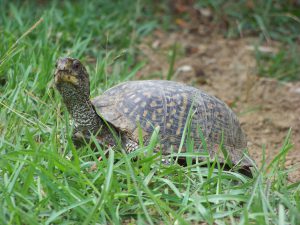
The abrupt downward end of the carapace and blotched pattern of the shell identifies this as an Eastern box turtle.
Photo: Molly O’Connor
Research suggests that each turtle will inhabit about 5 acres and that a single acre can support up to 16 animals. They are omnivorous and eat a variety of invertebrates and plants – they particular like worms and snails. They have also been known to feed on dead animals lying about, – and this should make some folks happy… they like to eat cockroaches!
Males look different than females in that their plastron has a concaved depression in it and their tails are much longer. Females will usually lay about 2 eggs in a nest she digs during rainy afternoons. She will lay more than one nest each season usually producing about 9 eggs each year. Baby box turtles are usually dark brown with a yellow stripe running down the middle of their carapace.
Many turtles, eggs, and hatchlings are lost to predators. Fire ants are a big problem as are birds, mammals and reptiles. Scarlet snakes are particularly good at finding nests. Most adults’ bare scars from attacks but usually survive by withdrawing into their shells. One animal, the wild pig, is believed to be strong enough to crush the entire shell consuming the turtle. Raccoons are also good at grabbing a limb before they can withdraw – there are many 3-legged box turtles running around, but they seem fine and still hunt well.
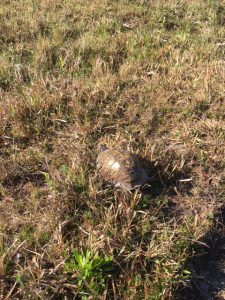
Gulf Coast box turtle heading across an open field.
Photo: Molly O’Connor
One problem they do have is fire. They prefer wooded areas, even the flowerbeds around your house. They do not dig burrows like the gopher tortoise but rather make “forms” in the pine straw or leaves – where they spend the cold and hot days of the year – they also do not like low humidity days and will build forms during these times as well – but these do not protect them from fires, whether wildfires or prescribed ones.
Despite all of this – they are one of the longer-lived turtles in our state. Though most do not reach the age of 40 years these days, they have the ability to reach 100!
No doubt this is one of the coolest turtles we have – and we really enjoy encountering them. Take a walk around after a rainy day and see if you can find one in your yard!
References
Meylan P.A. (Ed). 2006. Biology and Conservation of Florida Turtles. Chelonian Research Monographs No.3, 376 pp.























